Contact:
Lane Smith, Research Program Coordinator, NYSG, E: lane.smith@stonybrook.edu, P: (631) 632-9780
Stony Brook, NY, May 27, 2025 - Some recently-completed investigations address topics including: Impacts of microplastics in the aquatic environment, including the species that reside there; Flood risk planning for Lake Ontario's coastal communities; Aquaculture and/or restoration of several species (e.g., oysters, seaweed); Detection of aquatic invasive species; Optimizing existing control strategies for food borne pathogens; Providing a cost efficient and reliable tool in the Great Lakes for ID-ing hatchery vs. wild Chinook Salmon
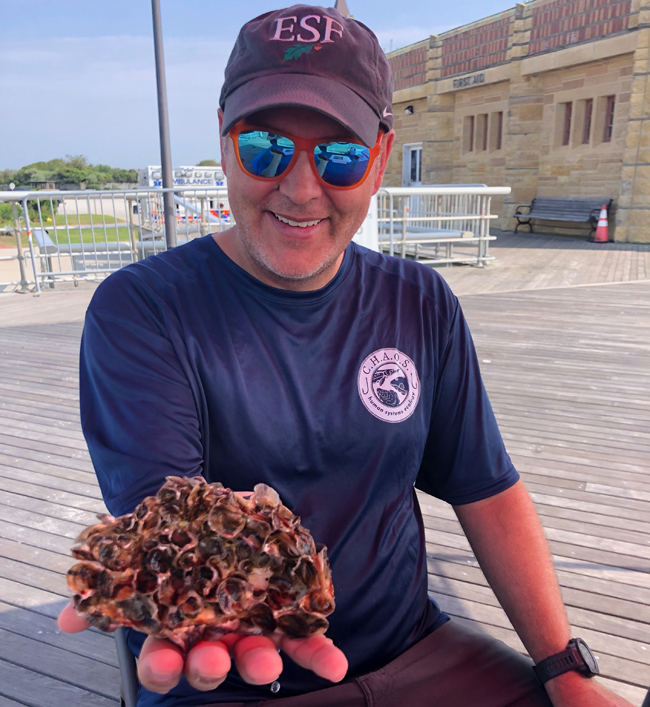
Dr. Joshua Drew holds a cluster of several juvenile oysters growing on the shell of a larger oyster. This ability to grow in clusters helps form oyster reefs which can help reduce storm surge and protect bays along Long Island. Credit: Grace Grimes
Stakeholder Perceptions of Oyster Ecosystem Services: A Mixed Methods Approach to Mapping Services that Improve Management Efficiency (R/FHD-15; Dr. Joshua Drew, SUNY College of Environmental Science and Forestry; and Dr. L. Jen Shaffer, University of Maryland; co-principal investigators)
Intertidal zones are dynamic spaces environmentally and culturally–they serve as places for play and recreation, peaceful refuges, sites for spiritual activities, grounds for commercial fishing operations, habitats for numerous marine organisms, and provide benefits for citizens living near healthy ecosystems, also known as “ecosystem services.” There is an ever-growing interest in the development and application of oyster aquaculture to support both a source of healthy aquatic food and as natural infrastructure for shoreline resilience.
Following interviews with multiple community groups, including yacht clubs, town governments, environmental organizations, property owner associations, and farmers, the researchers found that the groups shared many of the same concerns and values regarding oysters, and the services they provide. Among these user groups, water quality, economic value, and job creation emerged as shared benefits provided by oysters, and runoff and environmental variability were the top concerns as threats to oysters and the services they provide.
The researchers’ results indicate that including stakeholder valuations in the policy-making process can amplify the effectiveness of management plans and create more sustainable long-lasting impacts and facilitate more local buy-in for community-informed management actions.
“Together these findings suggest that many people on Long Island recognize the value of oysters and have a shared network of beliefs and concerns around which to build sound policy,” co-principal investigator Dr. Joshua Drew said.

Researchers at Stony Brook University tied Gracilaria tikvahiae and Agardhiella subulata to suspended lines to test their viability in New York waters, and found that A. subulata was a potential ideal target for seaweed aquaculture in the state. Credit: Christopher Gobler
Diversifying New York’s Marine Aquaculture Industry: Safely Integrating the Red Summer Macroalgae, Gracilaria, Into Oyster Farms and Other Systems (R/ATD-16; Dr. Christopher J. Gobler, Stony Brook University, principal investigator)
New York’s marine aquaculture industry consists mostly of small owner-operated oyster farms. Reliance on a single aquaculture crop leaves the industry at risk. Anything that disrupts the market for oysters negatively impacts oyster growers. For example, restaurant closures during the COVID-19 pandemic resulted in reduced demand for oysters. Diversifying what oyster farmers grow can increase the resilience of the industry. Researchers at Stony Brook University studied how to effectively grow the red-branching seaweeds, Gracilaria spp., and Agardhiella subulata, in both oyster and non-oyster aquaculture farms in New York estuaries.
The research team identified three aquaculture methods that provided high yields in oyster farms for Gracilaria spp and A. subulata: suspended lines, mussel socks, and oyster bags, with mussel socks and oyster bags providing larger yields on oyster farms. In the non-oyster farm setting, the researchers developed a land-based aquaculture setting consisting of a flowing seawater and filtration system and a modular dock system that can be deployed along existing floating docks.
The modular dock system provided the most yields, with A. subulata consistently growing faster than Gracilaria spp. in this setting. Another finding was that A. subulata is more widespread across Long Island than Gracilaria species and could successfully be aquacultured from wild fronds. Given these results and that A. subulata is successfully grown elsewhere, the researchers conclude that A. subulata would potentially be a promising target for seaweed aquaculture in NY.
“Given that A. subulata has been aquacultured in Florida and can be used for agar and medical purposes, A. subulata is a promising aquaculture target for New York,” principal investigator Dr. Christopher J. Gobler said.

Hare Lab students Hannah Hartung and Yuqing Chen search for oyster spat on shells deployed in the Hudson River for one month, hosted by the Yonkers GroundWorks Science Barge. Credit: Matthew Hare
Optimizing Restoration to Promote Ecosystem Services in New York Harbor Using Ecosystem Models R Systems, or: Spatially-Explicit Ecosystem Models Of Oyster Restoration Ecology (SEEMORE) (R/FBM-40; Dr. Matthew Hare, Cornell University, principal investigator)
This project addressed both the larval supply and filtration capacity of oyster populations within New York’s Hudson River Estuary. Oyster filtration provides an “ecosystem service” by drawing nutrient-rich particles out of the water column by consuming microalgae and depositing them in bottom sediments, restoring and enhancing ecosystems degraded by oxygen depletion.
Researchers used a 3D model to examine the interaction of hydrodynamics with oyster larval behavior and found that the spatial distribution of tracer (larval) settlement is largely dependent on where the tracers originated in the estuary. The investigation also mapped water residence times in regions of the estuary and compared the filtration services predicted for different oyster population sizes.
Over the course of testing in New York Harbor and to the north, researchers noticed a strong tendency for northward (upriver) dispersal of tracers in most contexts, helping to explain the continued isolation of the Tappan Zee remnant oyster population in the north. Ultimately, they found that the spatial distribution of larvae settlement was largely dependent on where the larvae originated in the shipping channel. The results also emphasize the importance of restoring oysters to more southern sites, and the challenge that relatively few larvae will settle there to maintain the population.
“This analysis suggests that oyster restoration has relatively high potential to supply impactful filtration services,” said Dr. Matthew Hare, principal investigator.

Researcher Steven Day secures a benthic frame in Lake Ontario as part of one of New York Sea Grant’s collaborative projects with RIT. Credit: Christy Tyler
Impacts of Microplastic Pollution on Benthic Ecosystem Functions and Services (R/ATD-16; Dr. Christy Tyler, Rochester Institute of Technology, principal investigator)
While most attention regarding plastic pollution has focused on the marine debris in the oceans, the Great Lakes are subject to similar issues. Scientists estimate that plastic enters the Great Lakes at a similar rate to the ocean, but we know very little about the impacts of plastic pollution on freshwater systems.
To better understand what happens to plastic in the Great Lakes, researchers incubated six different kinds of plastic for one year in four different types of freshwater ecosystems: a small rural pond, one of the Finger Lakes, a stormwater retention pond, and Lake Ontario. Plastic samples were placed in mesh bags attached to either a surface or bottom frame anchored in place. Over the year, the research team measured the changes in the physical and chemical properties of the plastics and the biofilm community that grew on the surface of the plastic samples. At the end of the year, the plastic samples were taken to the lab for further analysis.
Results showed that in systems with low nutrients, like the rural pond and Lake Ontario, less algae and bacteria grew on the plastic and more light could reach the surface of the plastic, causing the breakdown of the plastic.
Within the high-nutrient Finger Lake and stormwater pond, however, researchers observed a different community than in the lower-nutrient system. Over time, the plastic became denser and more likely to settle to the bottom - meaning that even plastic that originally floats in the water may sink and stay in the system where it started rather than move out towards larger bodies of water.
These results indicate that when plastic enters an aquatic ecosystem, what happens to it depends on the type of ecosystem - the volume of nutrient availability, the turbulence of the ecosystem, the presence of currents, and the type of plastic.
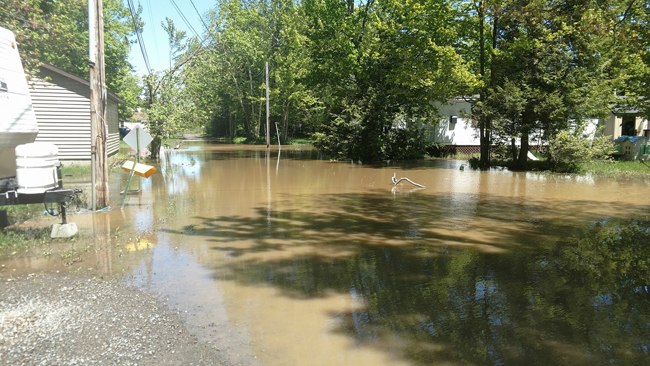
Flooding in the town of New Haven (Oswego County, NY) from Lake Ontario in 2017. Credit: NYSG’s 2017 Coastal Flooding Survey Project
Climate-Smart Flood Risk Planning for Coastal Communities on Lake Ontario (R/CHD-12; Dr. Scott Steinschneider and Dr. Richard Stedman, Cornell University; co-principal investigators)
Recent flooding along the New York Lake Ontario shoreline has significantly affected local communities, with inundation and erosion impacting thousands of homes and businesses. The recent flooding has introduced a heightened urgency among municipal, county, and state officials to better prepare shoreline communities for an evolving and uncertain flood regime, but local communities lack the tools and information available to respond to these evolving risks.
A “Flood Tool” developed by project researchers contributes an important new resource that local communities can use to better prepare for and manage future flood events, according to co-principal investigator Dr. Scott Steinschneider.
The Flood Tool is a probabilistic, parcel-level flood risk assessment modeling tool that predicts the probability of inundation of shoreline properties along Lake Ontario. It provides localized information on where flood risk is elevated over the next month, which can be used to help organize local emergency response efforts to reduce the impacts of impending floods.
“Overall, the information provided by the Flood Tool can help improve the resiliency of shoreline communities to more variable water levels, so that these communities can continue to flourish despite evolving risks along the coastline,” Steinschneider said.
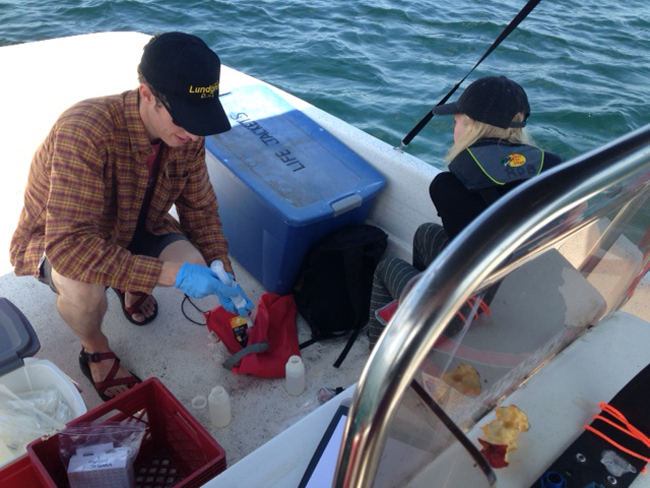
Researchers collect samples of hydrilla verticillata near Clayton, NY in summer 2018. Credit: Rob Williams
Development of a cost-effective, standardizable, environmental DNA method for the simultaneous detection of multiple coastal invasive species (R/XG-28; Dr. Jose Andres and Dr. David M. Lodge, Cornell University; principal investigators)
Without effective management, aquatic invasive species can degrade New York coastal habitats and ecosystems. Early detection of non-native species makes management more feasible, facilitating the protection and enhancement of these systems and the services they provide. However, early detection remains challenging along New York coastlines because traditional sampling techniques are unlikely to catch species before organism abundance surpasses the threshold at which eradication or other management is physically, economically, ecologically, or politically viable. Environmental DNA (eDNA) techniques make it possible to detect aquatic invasive species earlier than traditional whole-organism sampling, thus allowing earlier and more proactive management intervention.
Current assays offer the possibility of either single-species detection with quantitative PCR (qPCR) or digital droplet PCR (ddPCR), or the characterization of whole communities using metabarcoding. These tools, however, are prohibitively expensive and complex for many management agencies when there is a need to target multiple species.
This project resulted in the development of a cost-effective and potentially standardizable multiple-amplicon eDNA method to effectively conduct early detection of multiple targeted species in a single assay. Researchers successfully tested and applied this method in four of NY’s Great Lakes harbors where new invasive species are likely to become established, according to principal investigator Dr. David M. Lodge, resulting in the detection of several invasive species of interest to managers.
“Single species methods become prohibitively expensive when there is a need to target multiple species, and metabarcoding bioinformatics analyses are prohibitively complex for many management scenarios,” Lodge said. “Therefore, we developed a cost-effective and potentially standardizable eDNA technology to effectively conduct simultaneous early detection of multiple high-risk invasive species in New York State’s coastal waters.”
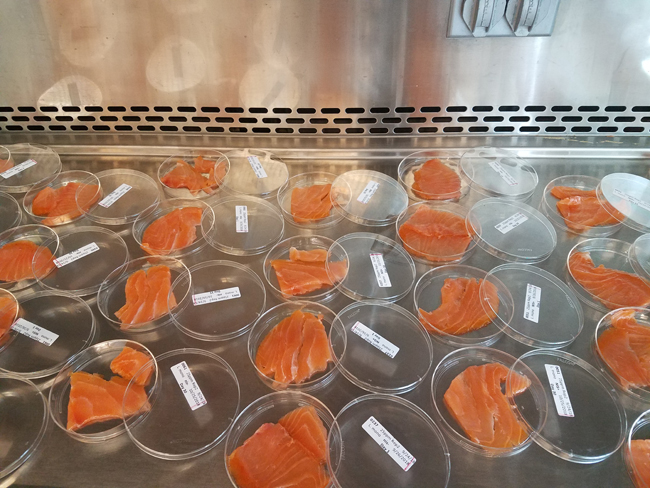
Inoculated samples of smoked salmon are readied for testing. Credit: Martin Wiedmann
Development and Optimization of Precise Listeria monocytogenes Control Strategies for Smoked Seafood (R-SHH-18; Dr. Martin Wiedmann, Cornell University; principal investigator)
Food borne pathogens and food safety recalls can lead to consumer illness and economic impact on associated industries. Listeria monocytogenes are a pathogen that if not properly detected can impact smoked seafood products such as cold-smoked salmon - an economically important product sourced in New York’s Great Lakes.
To support and protect New York fishermen, processors, and suppliers, and keep consumers safe, research was conducted to create novel strategies to optimize existing control strategies.
The results of this project, conducted at Cornell University, found that treatments using allowable concentrations of the natural antimicrobial peptide nisin are effective in reducing L. monocytogenes levels on cold-smoked salmon, with the potential to lower the risk of cold-smoked salmon products being contaminated with the pathogen. The authors also developed computational tools that can be used to assess how different concentrations of nisin can be used for a targeted reduction of recall risk.
Preliminary scenario analyses developed by the researchers, according to principal investigator Dr. Martin Wiedman, found that treating the cold-smoked salmon products with the food preservative nisin resulted in an 18-fold reduction of the recall risk for a given lot of 10,000 packages.
“Overall, our findings clearly support that appropriately designed nisin treatment of cold smoked salmon can reduce both the recall and public health risk associated with L. monocytogenes contamination of cold smoked salmon,” Wiedman said.
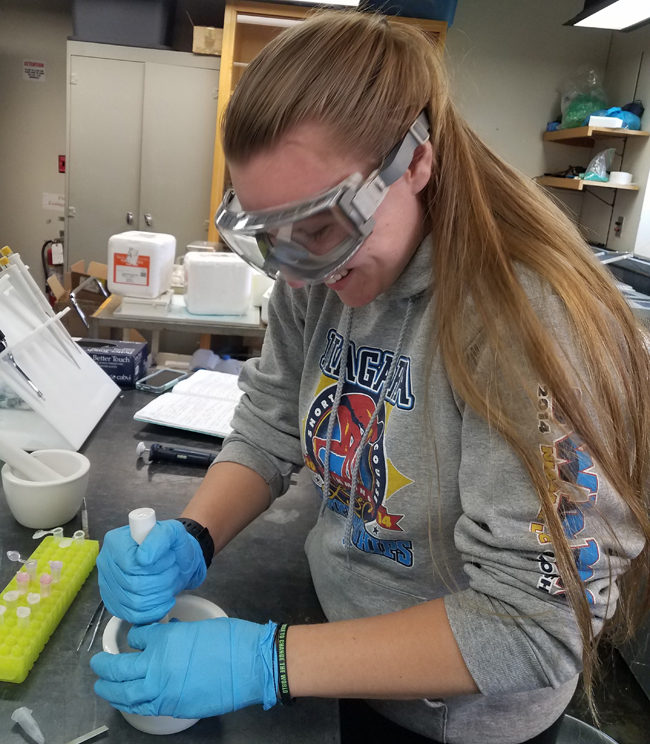
SUNY Cortland undergraduate student Marissa Kordal grinding frozen oyster tissue with a mortar and pestle as part of the RNA extraction protocol at SUNY Cortland. Credit: Laura Eierman
Transcriptomic Identification of Candidate Genes for Rapid Assessment of Plastic Marine Debris Exposure in Eastern Oysters (Crassostrea virginica) (R-XG-30; Dr. Laura Eierman, SUNY Cortland; principal investigator)
The eastern oyster (Crassostrea virginica) is a “habitat engineer” that builds reef structures in estuaries like Long Island Sound. These reefs provide habitat for hundreds of species and protect our shorelines. While the long-term success of restored oyster reefs depends on oysters reproducing to develop self-sustaining reefs, plastic pollution may undermine reproduction by impacting the sexual development of oysters.
A group of researchers at SUNY Cortland led by Dr. Laura Eierman explored how plastic may be altering the expression of genes that lead to the development of egg or sperm in the oyster gonad. Despite males still producing sperm, their gene expression appeared “feminized,” meaning that female gene expression lost variation with an unknown impact on the ability of the eggs to become successfully fertilized. Future studies will need to examine the impact of this altered gene expression in both males and females on fertilization success, and thus the success of the establishment of self-sustaining oyster reefs that benefit their ecosystems and the surrounding communities.
“If plastic is [causing oyster populations to skew female] and reducing the rate of successful fertilization, oyster populations may have reduced reproduction overall,” Eierman said. “While removal of existing plastic pollution is near impossible, it is critical that we work to move our society away from its plastic dependence, particularly single-use plastics, to protect our marine ecosystems and the resources they provide us.”

Chinook (“King”) Salmon collected at the New York State Department of Environmental Conservation’s Salmon River Fish Hatchery (Altmar, New York) as part of NYSDEC’s stocking program. The researchers’ parentage-based marking technique relies on taking genetic samples from every female fish that is processed by the hatchery so their offspring can be identified as stocked fish. Credit: Kimberly Fitzpatrick
Monitoring Against Runaway Wild Production: Genetics Provides a Cost Efficient and Reliable Tool For Identifying Hatchery Versus Wild Chinook Salmon in the Great Lakes (R/XG-31; Dr. Suresh Sethi, Brooklyn College; principal investigator)
Chinook (“King”) salmon are the most popular recreational fishery in Lake Ontario, but the sustainability of the fishery is closely tied to the relative balance between predator and prey fish within the Lake. While the number of stocked salmon are regulated by Lake Ontario managers, the number of naturally reproducing (“wild”) King salmon can exceed the number stocked and possibly place unsustainable levels of predation pressure on the prey fish population. Although important to the predator-prey balance, a lake-wide index of wild recruitment is lacking.
Monitoring the annual level of wild recruitment of salmon may improve estimates of predator-prey dynamics and help inform future stocking decision-making.
“Our project focused on testing a genetics approach to identifying stocked and wild King salmon in Lake Ontario,” said Dr. Suresh Sethi, principal investigator. “All stocked fish will have a mother in the broodstock that is collected by NYS Department of Conservation or [Ontario’s] Ministry of Natural Resources. If a genetic sample is collected from every broodmother, we can run a maternity test on any fish at large to determine if the specimen is born of a hatchery mother or whether they are a wild fish.”
Stocked fish will match with one of the broodmothers while any fish lacking a match must be a wild offspring. When this method was tested on King salmon in Lake Ontario, researchers found that they could accurately identify >95% of known-origin fish, which is similar to the accuracy of other methods for distinguishing stocked and wild fish. Since this method only requires collecting genetic samples from the broodmothers to “tag” every stocked fish, Sethi adds, it could be a cost-efficient approach to annually monitor wild King salmon production.
More Info: New York Sea Grant
Established in 1966, the National Oceanic and Atmospheric Administration (NOAA)’s National Sea Grant College Program promotes the informed stewardship of coastal resources in 34 joint federal/state university-based programs in every U.S. coastal state (marine and Great Lakes) and Puerto Rico. The Sea Grant model has also inspired similar projects in the Pacific region, Korea and Indonesia.
Since 1971, New York Sea Grant (NYSG) has represented a statewide network of integrated research, education and extension services promoting coastal community economic vitality, environmental sustainability and citizen awareness and understanding about the State’s marine and Great Lakes resources.
NYSG historically leverages on average a 3 to 6-fold return on each invested federal dollar, annually. We benefit from this, as these resources are invested in Sea Grant staff and their work in communities right here in New York.
Through NYSG’s efforts, the combined talents of university scientists and extension specialists help develop and transfer science-based information to many coastal user groups—businesses and industries, federal, state and local government decision-makers and agency managers, educators, the media and the interested public.
New York Sea Grant, one of the largest of the state Sea Grant programs, is a cooperative program of the State University of New York (SUNY) and Cornell University. The program maintains Great Lakes offices at Cornell University, SUNY Buffalo, Rochester Institute of Technology, SUNY Oswego, the Wayne County Cooperative Extension office in Newark, and in Watertown. In the State's marine waters, NYSG has offices at Stony Brook University and with Cornell Cooperative Extension of Nassau County on Long Island, in Queens, at Brooklyn College, with Cornell Cooperative Extension in NYC, in Bronx, with Cornell Cooperative Extension of Ulster County in Kingston, and with Cornell Cooperative Extension of Westchester County in Elmsford.
For updates on Sea Grant activities: www.nyseagrant.org, follow us on social media (Facebook, Twitter/X, Instagram, Bluesky, LinkedIn, and YouTube). NYSG offers a free e-list sign up via www.nyseagrant.org/nycoastlines for its flagship publication, NY Coastlines/Currents, which it publishes 2-3 times a year.